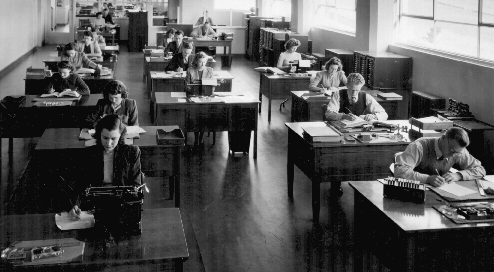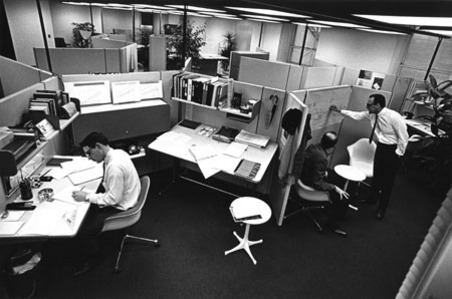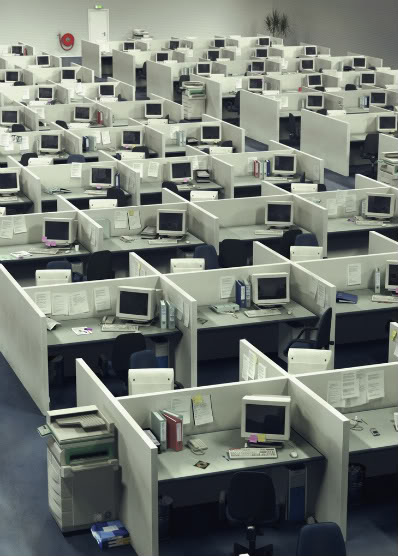
INTRODUCTION
Recently I did the Facebook Quiz ‘How well do you know me?’ for Ryan, who sits opposite me in work. Although I had only known him for three months when I did the quiz I scored better than his own sister – highlighting the fact that we spend far more of our waking hours living in our cubicles with our co-workers than with our significant others, friends or family.
Like some kind of miniature office a cubicle defines an individual’s a physical space in the corporate world that it’s occupant can call their own – a bit like your childhood bedroom. The fact that we spend so much time in these small, often uninspiring spaces yet we are still highly creative is a testament to the human ability to adapt to any environment. However cubicles may actually help their occupying cubistas be more creative.
Intrigued? Read on…
WHERE DID CUBICLES COME FROM?
Prior to the omnipresence of the personal computer companies had banks of clerical workers in typing pools servicing the corporate elite in their offices. Originally intended as high-end ergonomic furniture to allow office workers to see all their paperwork spread out the ‘Action Office’ was introduced in 1968 by Herman Miller Inc. That same year US tax law changed allowing companies to depreciate furniture much faster than fixed assets like buildings and suddenly the new ‘cubicle’ exploded across the office landscape.
The Action Office’s creator Robert Propst, designed it with increased productivity, privacy, and health (greater blood flow) at the expense of some inefficient use of space. He never intended the cubicle to be used to maximize space and increase employee density at the expense of everything else but that’s exactly what happened as Action Offices shrank into “spaces” that shrank further into the squarish cubicle we all know so well. By the 1990s many employees of similar skill levels could be packed into huge open spaces with increasing density like a Dilbert cartoon.
Years later the anxiety that cubicles cause is summed up by a lawyer friend (who did not want to be named like the Deep Throat of the Cubicle world) who had this to say about them: “the thing I hate about cubicles is the design. The fluffy carpety walls, damn it. The squareness. The lack of quaint Victorian features. The echoes of a prison cell”. Deep Cube went on to say “Another issue I have with cubicles is status. Cubicles have a low-status reputation. They say “knowledge industry cannon fodder”. They reek of temporariness and instability. You could punch a hole through a cubicle wall in a strop, and topple the whole lot of them in a real warp-spasm.”
THE EVOLUTION OF THE CUBICLE
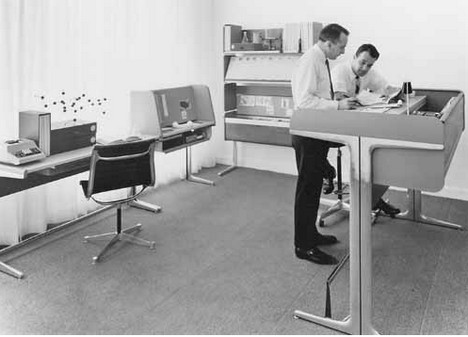 1968: the Action Office is introduced
1968: the Action Office is introduced
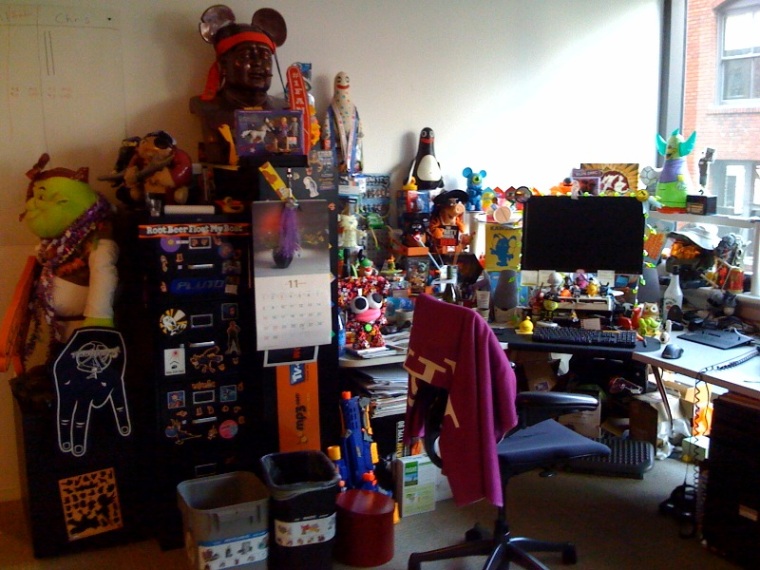 Now: What Every Cubicle Yearns To Be
Now: What Every Cubicle Yearns To Be
JUST WHAT IS CREATIVITY?
While creativity can take many forms I’ll just look at advertising/design since that’s what I do. If you’re reading this you have a career in media too and proficient at screening out the 247 to 3000 ads we see in an average day (depends on who you ask – click here here to find out more). Just like we get jaded with linguistic clichés through over usage (think of words like ‘honkey’ or ‘wicked’). The same thing happens with the visual language of advertising and design. Hence creative agencies continually get asked to produce ads/designs that are “outside the box” in order to “break though the clutter” (referencing the corporate landscape).
Cracking problems is the key to most white collar jobs. Stereotypically professions such as medicine, engineering, law, science have a more linear approach but they too have a creative element in problem solving. For graphic design there are less linear constraints than the professions above and therefore the parameters of the design brief are the essential. The key reason I was drawn to Graphic Design is the constant problem solving and there are no absolutely right answers – much like life itself.
Deep Cube, had this to say: “I could not work in a cubicle or open-plan office. Almost all my work is “creative” in the sense that my brain needs to be fully switched-on, analytical, thinking, comparing, coming up with ideas. There is very little of what I do which is mere “process” – coloring in, churning through lists, data entry, etc. That needs a LOT of mental energy. So I need to faff, in order to do bursts of work. If I felt that there was someone looking over my shoulder then I would not be productive: I would leave a spreadsheet up and let my mind wander.”
THE SEARCH FOR BELONGING
We yearn to think of escaping beyond our daily grind of phone calls, emails and padded cubicle walls (or frosted glass if you have an office). The many empty cubicles in most companies after the financial crisis are evidence that many people did indeed escape the confining walls of their cubicle whether by their choice or not. Yet despite this we miss having that workspace to call our own.
One previous creative director gave me the task of re-arranging all the desks of the creatives to fit the large space we were in. Each of the 14 designers approached me privately saying they didn’t want to move – it would have to be someone else. It turned out that no matter what layout I came up with no one wanted to leave their designated (non-cubicle) space. The eventual solution was a figure of 8 that didn’t move anyone very far from their current position and met with no resistance when introduced.
In 1993 ad agency Chiat/Day, declared a revolution in spatial possession when it moved it’s employees into newly renovated loungelike space in Venice, Calif. Employees were expected to park their belongings in lockers and check out laptops every morning as if renting a movie at Blockbuster. However the new concept had a fatal flaw: No one had a fixed place to work. Many employees simply stopped coming to the office, preferring to work at home. Eventually everyone got cubicles again when the agency was bought by a conglomerate.
OTHER SPACES
With the omnipresence of increasingly powerful laptop computers the desktop (both the type of computer and the physical desk) is becoming more redundant opening up the potential of other spaces in which to work. When I freelanced at Intuit on their Quickbooks pre-launch campaign a ‘war room’ was set up – really a long meeting room with several tables all pushed together. 20-30 people with laptops escaped their cubicle for two months by sitting around several tables all pushed together in one long meeting room. It is even more cramped than you might think but at the same time it had a party atmosphere as it was such a change from the cubicles they occupied for the other 10 months of the year.
By just using a laptop and cell phone many individuals can work out of Starbucks. LinkedIn’s sales team had to work out of Starbucks as so much of their clients’ agencies were in downtown San Francisco – a 90 minute drive from their main offices in Mountain View (Silicon Valley). With two or three meetings a day there was no point in going to the office at all so they eventually set up a separate office just for the sales team.
Michael Modes, a freelance copywriter has this to say about getting out of the cubicle: “The cube is a three-sided version of the dreaded blank page. So escape it. Go for walks, particularly outdoors. It’s where you go to solve problems in your own life. A breath of fresh is not called a breath of fresh air for nothing. If you need to get a grip on a creative problem, the biggest obstacle is gripping. A change of venue can relax your mind.”
Increasingly the biggest competitor to the cubicle for the “knowledge industry cannon fodder” cubistas that Deep Cube mentioned earlier is the option of working from home. You’ve probably done this already – typing from the couch in your pyjamas with the TV all day long can be rather appealing. While you’ll always be working near a window and you’ll never have any difficult face-to-face confrontations the biggest attraction for working from home is the fact that it is YOUR space. Escaping the cubicle for a day is a little like leaving home except you get to do it again and again.
HEAD SPACE
So you’re sitting in your cubicle working away/being creativity – what’s going through your mind? Whether or not they are a designer most people I know listen to music through iTunes as their moment of zen while working – again eeking out some sort of self identity in the process. As for me I watch movies from Netflix while I work. It takes me away from the stress of constantly meeting deadlines. It occupies the intellectual part of my mind while I craft the design at hand. The constantly changing plotlines/drama throws together different combinations of thoughts. For the linear part of my work I pause the movies. While it doesn’t work for most people it works for me.
Kathleen Turaski, principal at Resonance says this of cubicles: “I can work within cube land, as long as the culture allows for freedom to explore creativity and my cube is big enough for me to spread out all my stuff. What I mean is that the setting isn’t nearly as important as the mentality. Especially when working in the creative phase, I want freedom to leave my desk and get outside, sometimes several times a day. This could look like I’m ‘wasting time,’ but in reality getting out of the office helps me clear my head and solidify ideas quickly. I also want enough physical room – and freedom to be messy – so I can spread all my ideas out and have space to shuffle, sketch, rearrange.”
On the other hand producing ‘breakthrough’ creative all the time sounds like the most ideal job a designer could have. I once met an Art Director at Goodby Silverstein who had won a nationwide Art Director of the Year award yet within a year he had completely burnt out and left the profession for good. Just like the blank page at the start of any project is a daunting prospect, the Chiat Day’s experiment is having no permanent personal space is equally daunting.
BUT WHAT ABOUT THE WORK
I went to a design talk recently where one of the speakers mentioned that the most appealing thing in anyone’s portfolio’s is the ‘Hot Rod’ projects. He went on to explain what that was: Imagine you had to choose between two mechanics to fix your car. Both charge the same price and estimate the same amount of time to finish. However if one of them builds Hot Rods in his spare time which one would you pick to fix your car?
The 1991 book Generation X talks about cubicle occupants pinning up pictures of the palmy beaches to dream of in order to get through the daily grind. Instead of a physical place it seems that these days people dream of their ‘Hot Rod’ projects as their escape. Constant advances in web technology are increasingly making those dreams more tangible – after all Facebook was created in a dorm room.
If we were all in separate offices we would have less the cubicle effect i.e. the extremely fast exchange of ideas or as designers we can assess the quality of design in a few seconds. Or simply put if we see more good work on someone’s screens we get inspired or motivated to match that higher standard of work.
On the other hand while being super creative all the time sounds amazing it has it’s soul destroying quality. A friend worked briefly at London’s Attik design studio. Internationally renowned for their high levels of creativity their open plan studio with MTV playing on TVs all day long. And the days were very long. 9am to 6pm was for all the client work that gets charged by the hour. 6pm-9pm was for pitch work. 9pm to midnight was for working on whichever of their book design books was coming out next (and over the years there have been many books). Jaded and exhausted my friend left after 6 months. Most new designers hung on for 12 months and left. There were no cubicles, lots of highly creative work yet there was little happiness.
CONCLUSION
As a quasi-private space the cubicle defines the dimensions that is all ours in the working world. We yearn to break free, to escape to a sunny beach or a corner office (really a fully enclosed cubicle). Creativity needs some restrictions in order to cause that ‘ah-ha’ breakthrough moment in creative thinking. Likewise a designer will eek out any leeway in a tight brief in order to find some means of getting that creative high out of solving a problem.
Overly repressive environments or briefs will drive down the creative standards but a little but of restriction, whether in a project brief’s parameters or the corporate landscape, easily provide something to escape from and may actually help the creative process. Like the underground art and writing from the former Eastern Block, restriction inspired great ideas as creatives yearned to express themselves and were mentally stimulated from breaking free. (See Rafal Olbinski’s work click here). Similarly Oscar Wilde’s great writings have many hidden messages about his homosexuality disguised as being different from what society expects.
It would seem that there is a delicate balance with being overly restricted (producing uncreative work) and overly free (nothing to escape from) with the ideal being in the middle. Somewhere along the way the cubicle with it’s low level restriction as contributed to the creative process in a way we never realize.
LINKS
http://youcube.us/blog
http://www.cubiclesfilm.com/
http://www.withresonance.com/
http://www.frankwbaker.com/adsinaday.htm
http://www.attik.com/#/menu-latest/thegrandreturn
http://www.allposters.com/-st/Rafal-Olbinski-Posters_c33050_.htm
http://www.maxonfurniture.com/info/more-cubicles/computer-work-stations.aspx


